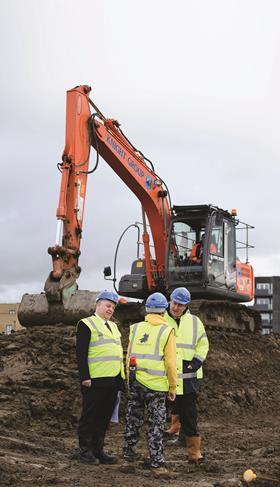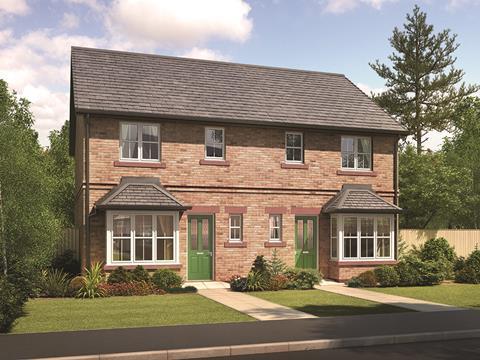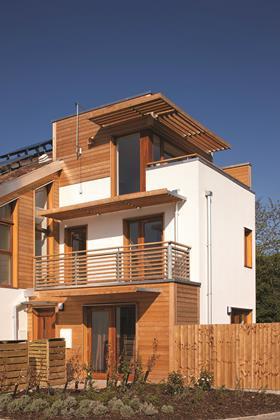In a week in which the government announced its intention to ‘directly commission’ up to 13,000 homes, you might think it had begun, finally, to get a grip on housebuilding. But its flagship Starter Homes policy is set to shake up the development industry, causing delays - and fears it won’t actually lead to more homes being built

This week’s announcement about the direct commissioning of homes by the government was not much of a surprise to those analysing the drift of government policy. Because David Cameron’s message to the Conservative Party conference this year was unambiguous: to be the party of home ownership in the UK, turning “generation rent into generation buy”. Notwithstanding this week’s announcement, the flagship policy behind this soaring rhetoric remains the Starter Homes initiative, offering cut-price new build homes for first-time buyers. But what escaped many people’s attention is how the policy has morphed since it was first trailed in 2014. It has switched from being a way of re-using redundant or problematic industrial and commercial sites, to becoming a product that will make its way on to every single significant housing site in the country, with a promise to build 200,000 rather than 100,000 homes. It is also now clear that Starter Homes will almost totally replace the development of new homes for subsidised rent.
While the initial response of housebuilders to the first version of the policy was warmly supportive, the response to its expansion was more muted - reflecting the realisation this potentially represented a huge shift in how they do business. One consultant, brought in by the government to work on the policy - and who asked not to be named - says: “Make no mistake, this is a very significant change for the development industry, and developers need to review what it means. It is a major change.”
Evidence is starting to emerge that this transformation, coupled with the massive shake-up happening in the housing association sector, is leading, at least temporarily, to a real hiatus in development. So how radical is the new policy really? And how significant and lengthy the hiatus? And, ultimately, will the policy when bedded down actually deliver any more homes than would otherwise be planned?
Home owning democracy
The idea behind the Starter Homes policy is that it offers to first-time buyers under the age of 40 the chance of getting their hands on a new home by making the homes available at a 20% discount to the market value. The lucky buyer will then be able to sell the home on at its full market value as long as he or she lives in it for more than five years. Under the initial announcement of the policy, specific brownfield “exception” sites are to be dedicated to build 100,000 of these, with the discount to be funded by the government dropping requirements for planning contributions and grant-funding infrastructure where necessary. However, last autumn the government made clear another 100,000 are to be built on standard large sites, with all sites above a certain size (yet to be determined) having to include Starter Homes (for details, see box). These homes are in large part likely to replace those traditionally provided by developers for affordable rent under section 106 deals, although the exact mechanism for achieving this is not yet clear.
The policy is supported by a range of other measures such as more cash for shared ownership homes and the extension of Right to Buy, all designed to boost home ownership. For cynics, the reason for the government’s new focus is obvious: home owners are simply much more likely to vote Conservative. Indeed, at the last election home owners were more than twice as likely to vote Conservative (47% did) as Labour (just 23%). Worryingly for the Tories, however, official figures show home ownership in the population has declined from its peak of over 70% in 2003 to just 65% today, its lowest level for over 25 years. Worse still, the proportion of young people able to buy a home has collapsed, with just 10% of 16-24-year-olds owning their own house in 2011/12, compared with over a third in 1991.
The Starter Homes policy is the subject of a big political row, with the likes of housing charity Shelter standing alongside the Labour Party in questioning the value of replacing the construction of homes for the poorest with Starter Homes, which will be sold for up to £450,000 and are likely to be accessed by young professionals on good incomes. Shelter estimates a household income of around £77,000 per annum will be necessary to buy the most expensive Starter Homes.
The reason, however, that the Starter Homes policy in particular is also getting the construction industry hot under the collar is because the latest form of the policy fundamentally alters the accepted way in which the residential development system works. Those working in the industry say this raises questions over whether it will result in any more homes getting built, for a number of reasons.
Currently, when developers receive planning permission, they negotiate with the planning authority around an obligation to provide affordable housing on the site. The proportion required is agreed after (often protracted) discussions between the authority, which has conducted a housing needs assessment of its area, and the developer, which conducts a viability assessment of the site. The developer then builds out the site, usually after agreeing to sell the affordable homes to a housing association at a significant discount to the market price. These deals are not made public, but estimates of the typical discount housebuilders have to accept vary from 40-45%, according to Steve Errington, chief executive of fast-growing northern housebuilder Story Homes, to around one third, according to Jim Martin, managing director of London-based housing QS Martin Arnold. Housebuilder Barratt, for example, stated in its 2015 report and accounts that the average sale price for an affordable home is £112k, less than half the £235k average for its private sale homes.

Double bubble
This all means that the requirement to sell some homes at a 20% discount, instead of in bulk to housing associations, somewhat paradoxically has the potential to massively improve developers’ returns. Even the Home Builders’ Federation (HBF), which is attempting to secure the most favourable terms for the scheme from the government for its members, admits that the 20% Starter Homes discount is less than the usual discount offered to housing associations for affordable rented homes, with policy director David O’Leary saying: “Our assumption is that 80% market value is more than housebuilders get from sale to housing associations.”
And that uplift in return occurs even if you assume that the homes will be sold at a genuine 20% discount to the market value. However, some say the reality is that, with new home valuation a much-contested area, and no clarity given yet on how market values will be arrived at, there are potentially even greater profits to be sought. As Martin Arnold’s Jim Martin says: “You give a developer a spreadsheet and they can give you a reason why the market value of a home is X, even if in reality that figure is the true market value plus 15%.
“[Under the Starter Homes policy] they could easily end up selling the homes for just 5-10% below true market value. So the developers are getting double bubble. The reality is they’re going to make a fortune. It’s a licence to print money.”
The new system is not simply a gift to the developer, however. Against the viability benefit, is one significant headache which seriously impacts on the expected cash-flow from a site. In the traditional model the sale of a proportion of homes to a housing association was agreed up front, allowing the developer to bring in cash quickly to finance the later stages of the site build, making up for the low price achieved. Under the new model no housing association sale need take place, meaning the developer takes on additional sales risk and - importantly - loses the benefit of all that early cash-flow. This can particularly impact smaller housebuilders for whom this cash-flow benefit is vital. Mash Halai, partner at consultant John Rowan & Partners (JRP), says: “A mainstream developer like Crest Nicholson or St George can carry on anyway, but many of the smaller builders can’t go ahead without the deposit from the registered providers.”
Hiatus
The upshot of all of this change is that developers need to redo their sums and adjust their business models before proceeding. According to many experts in the sector, this period of readjustment is causing a worrying hiatus, as housebuilders assess whether to re-open negotiations with planning departments to allow them to build Starter Homes instead of traditional affordable homes. Martin says: “Everything’s gone into freeze-frame. People are just calling a halt to things and going back into planning.” JRP’s Halai agrees: “We’ve been experiencing a hiatus getting deals over the line. We’re talking about four to five months of deals being delayed - that could be 15-20% of the year’s deals, and it will impact upon the number of homes built next year.”

This problem is exacerbated by the unexpected decision by the government last year to cut the rents housing associations are allowed to charge their tenants. This has thrown these organisations into even greater turmoil than mainstream housebuilders, meaning that, even on sites where the housebuilder wants to honour its planning commitment to sell affordable rented homes to an association, there are at present few housing associations willing to buy.
Story Homes’ Errington, who believes that overall the impact of Starter Homes is still likely to be positive, says he has been hit particularly hard by this combination of factors. “We’ve got a real viability issue on sites now where we’re not getting much take-up for the affordable housing. We’re going back into negotiation with the local authorities to get Starter Homes on the sites instead but it’s caused us delays and it’s caused us uncertainties.”
Errington cites the example of one site where Story Homes invited 20 housing associations to bid for the affordable homes and didn’t get a single expression of interest. “We’ve gone back to the local authority to say can we do Starter Homes, but we can’t complete on the deal for the site until planning is agreed. We may end up with a three-month delay, and we need it bottomed out,” he says, adding: “It isn’t just us. Any other major housebuilder is having exactly the same problems.”
Adding to the delays is the fact that, for obvious reasons, many local authorities are not keen to see affordable homes available to rent for the poorest being replaced by homes for sale to those on middle incomes. In addition, the desire of developers to renegotiate planning puts more strain on already thinly stretched planning departments. Ian Tant, partner at planning practice Barton Willmore, says: “A number of local authorities - possibly the majority - are opposed to the idea of Starter Homes being offered in place of affordable housing. Consequently, housing officers have so far appeared reluctant to accept Starter Homes as part of the affordable housing package. The effect is that those developers seeking to put them forward are being rebuffed by the local planning and housing authorities.”
The final issue adding to the delays being experienced is the lack of certainty around the Starter Homes policy package itself. A huge amount of information about how the scheme will work, including vital issues such as which sites will be required to provide Starter Homes and how many, remains to be even consulted on, let alone finalised. Developers, planning authorities and housing associations are therefore trying to make important decisions about schemes without knowing the rules of engagement. The HBF’s O’Leary, who says the government is likely to consult on further details of the scheme early this year, says: “At the moment we can’t tell a huge amount about how it is going to work. So much is still up for grabs or unknown.” Story Homes’ Errington says: “It’s all a bit of a surprise, and to be honest the government could have provided more of a consultative lead-in. We’ve got a bit of an uncertain climate.”
Starter Homes - how do they work?
The promise of the government is to provide 200,000 homes for sale in the current parliament at a 20% discount to market value for first-time buyers under 40. Their cost will be capped at £250,000 across the country and £450,000 in London. The initiative is essentially two policies in one. One is for 100,000 homes for brownfield “exception sites” - former commercial or industrial land, which developers can build without incurring the normal planning obligations, and which are likely to need government funding. The other is a further 100,000 homes on “reasonably-sized” private sites at a rate to be set by government. The whole initiative is to be funded by £2.3bn over the course of the parliament, but where this funding will go, like much else about it, is very unclear.
Most in the industry assume the homes provided on standard sites shouldn’t require subsidy, given the reduction in affordable rented homes proposed. So far the government hasn’t said what size of site will be subject to the Starter Homes obligation, or what proportion will have to be provided - though it is clear the number is likely to be set centrally, in a major break from current planning rules. The government has also not clarified if Help to Buy will be available on Starter Home purchases, or how the provision will interface with existing affordable housing obligations negotiated with local authorities. A consultation laying out options for some of these issues is expected early this year.
New homes
All of these issues could, however, be described as transitional problems: creating difficulties today, but liable to recede as the policy beds down. And while the critics of the plan from the political left object to the principle of prioritising policies to help middle income home-buyers rather than the poor, for the industry the issue is much more about whether it will be effective in causing more homes to be built. But where the government might have most expected support, it has seen little. Accountant KPMG described the policy as “free money for the lucky few”, the wider impact of which will just be to raise house prices for everyone else.
The former head of the civil service, Sir Bob Kerslake, has already voiced concern about what is euphemistically called “additionality” - whether the policy will add to the total volume of new home development.
Kerslake told the House of Lords that: “In the policy as now proposed, Starter Homes are clearly to be instead of, not additional to, affordable homes to rent,” and branded their description by the government as affordable as “Orwellian”.
For economists, the likelihood of “additionality” comes down to one thing: is the offer of a 20% discount for new homes likely to make home ownership accessible to people who traditionally have not been able to buy. If so, goes the argument, the policy will create greater demand for homes for sale, enabling housebuilders to sell - and build - homes more quickly. The problem is, the government already has an offer - Help to Buy (H2B) - which effectively reduces the entry price of a home by 20% (albeit the buyer can’t cash in on this benefit when he or she sells in the same way as will be possible with Starter Homes). Therefore, while Starter Homes might be more attractive to those who can already buy using H2B, they aren’t necessarily any more affordable for those currently priced out of the market. Thus, while HBF’s O’Leary says achieving additionality with Starter Homes is possible, it is by no means guaranteed. “The worst case scenario is that sales are simply switched from Help to Buy to Starter Homes, and a lucky few get a great deal but no additional homes are created. That’s our overriding concern,” he says.
This problem could be addressed in an instant by allowing buyers to use Help to Buy on Starter Homes properties. Together these policies would add up to a 40% discount and would certainly be likely to open up the homes to those currently priced out. However, whether Help to Buy will be offered on Starter Homes is one of the points the government has yet to clarify about the policy, and O’Leary says the mortgage lenders have raised concerns over any move to do this. Without this, it is in fact possible Starter Homes could actually slow the rate of development, because housebuilders will have to achieve a higher rate of sale on sites than they have previously in order to make up for the lack of a housing association pre-sale. “Without a guaranteed buyer, we will have to drive a higher sale rate,” concedes Errington.
In fact, the government has already essentially conceded the point. In the impact assessment for the Starter Homes policy, it said of the Starter Homes built on conventional housing sites, that they “will not be additional to housing supply”.
Given all of this, it is hard to escape the conclusion that the policy is setting about a radical and disruptive shake-up of the development industry to pretty uncertain effect. O’Leary makes clear that the housebuilding industry - which many say potentially stands to benefit significantly from the proposal - will work hard to make it a success. But for the wider industry the outcome is unclear. “It’s one of those policies,” says Martin, “dreamt up by people in the Treasury with brains the size of Wales but who don’t know how the world works.” The rest of the construction industry, looking for more work from housing developers, will have to hope he’s not correct.



























No comments yet